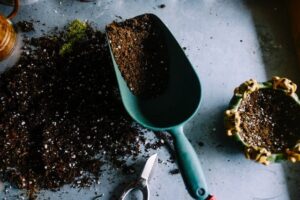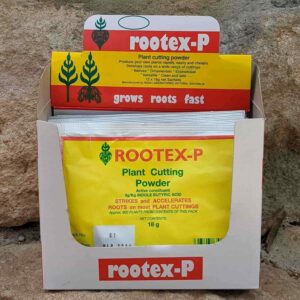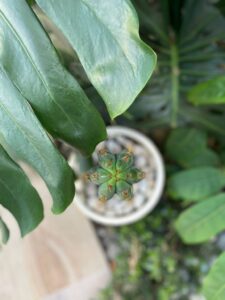Almost all cacti have evolved to be adapted to growing in regions with sparse or seasonal rainfall. They are kind of like little water tanks, soaking it up while they can and storing it for times of drought. Some cacti, like the infamous Peyote (Lophophora williamsii) or common Golden Barrel (Echinocactus grusonii), have adapted to last up to 4 months without a drop of water. Large, fleshy columnar cactus, like the San Pedro cactus need a little more water than these compact desert species. However, correct watering is still vital in maintaining optimal plant health.
So if you want to really elevate your cactus growing, you want to use water that is pH adjusted and free from contaminants like bacteria or chemicals that may harm our plants, like the chlorine in tap water.
Rainwater
Using collected rainwater is an excellent option in theory. Rainwater is very low in dissolved minerals and has already been pH-adjusted for plants in most regions. However, many people do not live somewhere with heavy enough rainfall to collect enough rainwater for their plants. And even if you do, you will need to think about storage, which can be a breeding ground for mould and bacteria. Some people deal with this issue by adding a source of chlorine to their rainwater, but at that point, you may as well skip the hard work and use tap water. The only real solution to this is if you can water your plants with freshly collected rainwater.
Tap Water
In most countries, it is routine for water treatment facilities to add chlorine-containing chemicals to tap water in trace amounts to prevent the growth of dangerous pathogens. These chemicals include free chlorine and sodium hypochlorite. Both of these chemicals can react with organic material in the water lines to generate chemicals known as chloramines, which also aid in sterilising tap water. At the concentrations present in tap water, these chemicals will not harm the tissues of a plant, but they can damage the microbiome in your soil. Whilst most people can make do, for the hardcore collectors with expensive collections this can be undesirable, especially if you use compost or compost teas or rely on soil microbes for a healthy plant.
Removing Chlorine From Tap Water
As stated above, you don’t HAVE to do this. Your cacti should survive with regular tap water with minimal fuss. But if you’re wanting to go the extra mile for your plants it’s worth considering.
There are several ways people deal with chlorine in water. One common way is to simply let your tap water sit out and allow the chlorine to evaporate. However, most people don’t realise how ineffective this is. It varies widely based on the shape of your container, but on average, it takes a litre of water about a week at room temperature to decant. Even something as small as a 20L bucket could take months to lose all chlorine.
In our opinion, the best option is to use a dechlorinating chemical. These chemicals don’t remove the chlorine; they render it harmless. Chlorine, hypochlorite and other sterilising chlorine compounds work by oxidising other molecules. Oxidising the molecules that make up the structures of bacteria cells can effectively destroy the cell. However, these oxidising chlorines can’t determine what is and isn’t a cell, they oxidise whatever is available to be oxidised. You can take advantage of this by introducing an easily oxidised chemical that will effectively “use up” all the chlorine.
We recommend two chemicals as reducing agents to effectively neutralise chlorine’s oxidising capacity: sodium thiosulfate and ascorbic acid. Both of these are strong enough reducing agents that chlorine will preferentially oxidise them.
Sodium thiosulfate is stable in alkaline solution, so a concentrate can be prepared ahead of time that only requires a few drops to neutralise the chlorine in a bucket of water. When it reacts with chlorine or hypochlorite, it generates chloride, a non-oxidizing form of chlorine that is also a bioavailable nutrient, as well as sodium sulphate and elemental sulphur, which proceeds to react with water to form sulphate. Because you only need a tiny amount, the sodium introduced to the soil is negligible. Sodium thiosulfate is completely safe for plants, people, and animals. It is commonly used in aquariums to deal with chlorine and in swimming pools to adjust chlorine levels that are too high.
Ascorbic acid, otherwise known as vitamin C, is another good option; however, it is more expensive and requires more material to neutralise the same amount of chlorine. The resulting products are chloride and dehydroascorbic acid, a generally inert chemical.
If tap water is used, we also highly recommend adjusting the pH to around 5.0-6.0. In most places, water comes out of the tap with a pH of around 7.0, but with a cheap hydroponic pH test kit and some pH lowering solutions (both of which you can find easily at hardware shops or online), you can change that. You can buy fancy hydroponic pH-lowering solutions, but regular white vinegar works just as well. A rate of about 3/4 cup of vinegar per 8L watering can lower 7.0 pH water to around 5.5 pH.
How often should I water a cactus?
It’s tough to write instructions on how often to water a cactus because it depends on many factors: the species, age of the plants, your climate, how much sun it gets, the pot size and type and your soil composition. As an incredibly rough guide, Cactus Culture Australia is based in Brisbane, and we water most of our potted cacti:
-
Full soak, as often as once a week in Dec, Jan, Feb;
-
Full soak, every 2 weeks in Nov & Mar
-
Light watering every 2 weeks in Apr. Sep, Oct
-
Light watering every 3 weeks in Jun, Jul, Aug
Rather than relying on a fixed watering schedule, we highly recommend investing in a soil moisture meter. They are reasonably cheap and available at most gardening and hardware stores.
With the aid of a moisture meter, do the following:
Spring, Summer & Autumn: Soak your cactus whenever it drops to around 15% moisture;
Winter: Just give your cactus a light watering if it drops below 15%. Never go above 40% in winter, and don’t let it drop below 10% at any point in the year.



